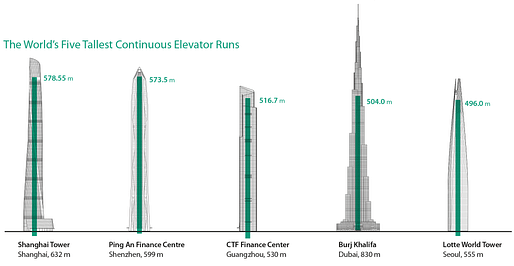
The first commercial passenger elevator was installed by Otis Elevator Company in 1857 and climbed at a glacial pace of 40 feet a minute, though it felt staggering at the time. Since then, we have come a long way both in terms of elevator speeds and in terms of the heights these elevators are needed to traverse in order to meet the needs of super-tall structures around the world. Today, an Otis elevator in Dubai soars at a speed of 22 mph, which is still less than half the speed of those topping new rankings for the fastest elevators in the world.
Looking into the ways these improvements in elevator speeds have effected our urban environment, the Council on Tall Buildings and Urban Habitat has released new research in a study titled Vertical Transport: Ascent & Acceleration. The study defines the fastest and longest elevator runs and shows a strong correlation between the increase in elevator speeds and the increase in skyscraper heights. As elevator technology advances and allows building dwellers to move about floors with greater efficiency, it allows developers to build structures at growing heights.

According to the Council, the study grew out of a collaboration with Guinness World Records to identify the commercial building with the fastest elevator speeds and longest vertical runs. The building taking the title turned out to be the Shanghai Tower in China which, at 632 meters, also holds the record for the second tallest building in the world. With elevator speeds topping out at 20.5 m/s, or roughly 46 mph, the Tower's elevator is also quite a bit faster than Disney's haunted one—the Twilight Zone Tower of Terror which hurls its riders at 39 mph.

Above is a list of the "Fastest Elevators in the World." 4 out of the top 5 are located in China, where rapid urbanization has been met with a desire for ambitious "super-tall" skyscrapers. According to the Washington Post, "over the past decade, the vast majority of elevators installed around the world have been placed in China" and "it has been estimated that by 2020, 40 percent of all elevators will be in China."
The Middle East has also become a global center for future mega-tall skyscraper construction. Saudi Arabia's Jeddah Tower, poised to be the tallest building in the world with heights exceeding 1,000 meters, will likely challenge these records upon it's completion. The skyscraper is employing new elevator technology that employs carbon fibre lift cables, as opposed to the typical woven steel. Called the Ultrarope, the cables are 90% lighter than the alternatives allowing the tower to reportedly feature an elevator run of 660 meters and double-decker elevators that exceed the current record of 10 m/s for such systems.
No Comments
Block this user
Are you sure you want to block this user and hide all related comments throughout the site?
Archinect
This is your first comment on Archinect. Your comment will be visible once approved.